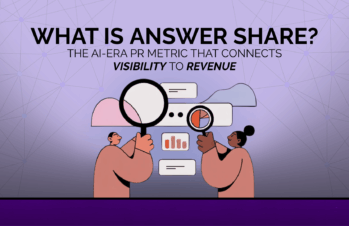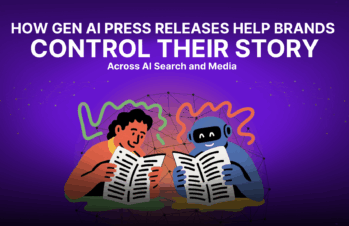One thing you should know about public relations? It moves fast. And with PR evolving all the time, it’s no wonder PR pros have to evolve right along with it.
Below, we’ll discuss nine of the biggest emerging PR trends and changes reshaping the modern PR landscape, plus the key strategies our PR experts are implementing in 2025.
Related reading: Build a Successful B2B PR Strategy
1. PR and Marketing Will Become Further Entwined
The lines between PR and digital marketing are blurring, and PR professionals have to be ready.
While PR efforts aim to land that press hit, podcast interview, or appearance on that YouTube show, public relations professionals have to go further by amplifying those hits everywhere. That means sharing the hits on different social media channels, knowing when and how to request backlinks, and suggesting possible repurposing options for those hits, among other things.
This all requires a knowledge of digital marketing and plenty of collaboration between the two departments. By working cross-departmentally and staying up to speed on changes and trends in the digital marketing world, experts can ensure they’re getting the most potential out of every win.
2. PR Content Must Be Culturally Relevant
Companies should certainly continue to focus their PR strategy on staying top-of-mind, but it’s more important that companies stay relevant. Every piece of PR content needs to tie into the current issues and ethos of culture.
In a nutshell: Don’t be tone-deaf.
“Cancel culture” is certainly a buzzword today, but it has always played an important role in PR. Every brand and business needs to be culturally relevant, which means keeping up with the latest news stories and current cultural values to inform how you choose to portray your company online. It also means clearly defining your brand’s values and investing in effective crisis management (more on that later).
A recent study found that consumers increasingly put their money where their morals are, focusing their spending habits on companies that align with their values. Don’t let your company get left behind in the dust. Instead, focus on your brand’s mission, what you’re offering, and how you contribute to the greater global narrative.
This extends from personal to private choices, roping in corporations, brands, and individual leaders. Leverage content creation across various digital channels to effectively communicate the values and messages you want to share.
Related reading: The Difference Between PR, Earned Media, and Crisis Comms
3. Personal Branding Will Become a PR Strategy
Like many of the PR trends on this list, this one mixes traditional approaches with modern needs.
As the world continues to connect digitally, personal branding has become increasingly important for executives and key figures in your organization. Whether networking in person or online, digital personas help customers, prospects, and colleagues get to know more about your employees and brand.
Every company leader needs a digital presence just as much as the business itself. Think of each digital profile as an extension of your company that shows your brand’s human side.
And to be a digital leader, you need to foster connections online. This means creating a personal brand that people can consistently interact with across various platforms online. In the B2B space, LinkedIn holds the most value, but each channel offers valuable touchpoints.
Thought leadership is also critical for the C-suite, and a company will thrive even more when its team of leaders shows up consistently online and offers valuable content to the industry.
4. Transparent Branding Becomes Crucial in Public Relations
As an extension of personal branding, customers want to know what drives your brand. This means highlighting transparent values, social initiatives, and actions customers are concerned about while amplifying your presence in key industry spaces.
When we work with clients, we find that brand searches go up when we show them how to develop their brand and make it consistent across platforms. PR strategy in 2025 is less about sending out a few press releases every quarter and more about painting an all-encompassing portrait of a company, from social media marketing initiatives to traditional public relations plans. Basically, you have to maintain momentum in between news announcements.
Branding is also crucial for PR because it provides a proactive way to mitigate damage to a company’s reputation and aids in crisis management. As we mentioned earlier, brands are especially susceptible to “cancel culture.” Strong branding can counter this if PR strategies are directed at showing the company’s values, workforce, and unique qualities.
Practically speaking, this helps with crisis communications and when communicating with media—especially journalists—who will often research companies online prior to writing. If your branding is strong across all platforms and you’re sending a consistent message, the media is more likely to pick it up and even reach out to you. Transparency is just one of the many PR trends that will be around for a long time, so get comfortable with this one.
Related reading: The Case for Crisis Communication as a Tool for Reputation Management
5. More Marketing Dollars Will Go To Sponsored Content and B2B Influencer Marketing
Think of sponsored content and B2B influencer marketing as “evangelists” for your brand. These B2B influencers will get your product or service in front of the right people. PR strategies in 2025 will focus less on marketing to the masses and more on marketing to targeted prospects (even if you’re tapping into micro-influencers with smaller audiences).
This is because more and more customers are making their purchasing decisions based on word-of-mouth practices. PR strategies need to shift to this ideology, and leveraging influencer marketing is the best way to do so because influencers significantly drive purchasing decisions across audiences.
Thought leadership is critical here because it builds brand awareness and forms connections on behalf of your brand or business. Even if the thought leader isn’t on the staff of your company, connecting with a thought leader in your industry—and implementing an influencer marketing strategy—will increase brand awareness and augment your brand’s trustworthiness.
Related Reading: B2B Influencer Marketing Trends for 2023
6. Successful PR Is More Than Media Relations
In 2025, it’s not as much about cultivating relationships with media as it is about cultivating relationships with stakeholders in your market.
This means traditional PR strategies don’t work as well, and companies need to adapt. It’s a digital-first world in terms of marketing, and companies can get in front of the right audience by “meeting” them in various ways.
Related reading: The Modern Roadshow: Why B2B Event Marketing Must Evolve
Unlike the media, stakeholders exist and interact in different ways (depending on who you’re talking to), so brands need to craft digital experiences that meet these people where they already are. Traditionally, PR strategists would send press releases and media alerts to the media, hoping to garner attention. Modern public relations strategies go beyond media outlets to reach people through the digital channels and platforms they’re already using.
Digital experiences include social media campaigns, podcasts, virtual reality experiences, infographics, remote summits, LinkedIn Live sessions, and more.
7. Short-form Video Content Will Become More Important for Building Buzz
We all know TikTok has changed content marketing and promotions for good—and short-form video content will continue to soar in 2025. To help their clients build more buzz online, publicists need to sharpen their video storytelling strategies this year.
Influencer Marketing Hub reports 47% of marketers agree that short-form videos are the best way for consumers to learn about a product or service. Short-form videos have the highest ROI and the best chance for lead generation, engagement, and virality.
Rather than just relying on the traditional press release, strategists should hop on this PR trend to create compelling short-form video content that tells their clients’ stories. Make sure it is clear, concise, and aligns with the brand’s mission and values. Audiograms and other videos can even highlight recent PR wins and accomplishments for better visibility!
If you’re looking to expand your skill set and edit these videos yourself, applications like CapCut and Splice are incredibly user-friendly resources to try. Or, if you only want to be involved in the brainstorming process, find a team member with solid multimedia capabilities.
After creating the content, share it with your media contacts and repurpose it for use across all social media platforms, particularly TikTok, Instagram Reels, and YouTube Shorts. Consistently sharing what your brand is up to online will boost SEO and spark media outlets to reach out.
Related reading: The Ultimate Guide to Social Media Platforms for B2B Influencer Marketing
8. Unfiltered PR Content Is In
Keep it unfiltered, brands! While we all love a glossy and glamorous product pic, consumers are looking for more authentic brand content in 2025.
From simple product demonstrations to images without obvious editing, there is an emphasis on authenticity that will change the PR industry for good, especially as AI and other advanced technologies leave us wondering what’s real and what isn’t.
As you plan your content for 2025, consider the value in maintaining authenticity—it’s more than a PR trend! Showing your brand precisely as it is will build consumer trust and make it stand out from the competition.
Related reading: Here’s How to Build Trust In Your Brand
9. Talent Acquisition Will Be a Natural Outcome of PR
As brands and businesses focus on generating thought leadership and building a strong digital presence, they’re simultaneously crafting a message that helps bring in the best talent for their industry.
Our PR team has found a trend among clients: They want to attract the best talent and keep it, too.
How does this tie into PR strategy in 2025? People want to work with the best companies, the ones where leaders and team members are transforming the industry. To attract and acquire the best talent, a company’s brand messaging must prove that it is a desirable place to work.
It’s a natural outcome of PR, or good PR, because successful brand positioning not only automatically catches the attention of the client but also earns attention from the rest of the industry (and potential talent to acquire).Is 2025 the year to rethink your PR and digital marketing strategy? We’re here to help. We work with clients around the globe and turn their brands into industry titans—let’s chat.




